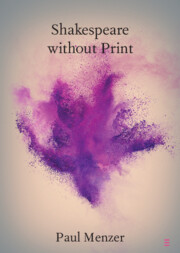References
Adorno, Theodor (2011) Quasi una fantasia: Essays on Modern Music. London: Verso.
The Athenaeum (1905) May 13, 4046.
Barker, Harley Granville (1957) Plays and Players Magazine, vol. 4. London: Hansom Books.
Barton, John (1992) Playing Shakespeare. New York: Anchor Books.
Baudrillard, Jean (2012) Impossible Exchange. London: Verso.
Bergson, Henri (2002) Key Writings. New York: Continuum.
Berry, Cicely (2006) The Actor & the Text. London: Virgin.
Bristol, Michael (2021) “Character Studies,” in Gajowski, Evelyn (ed.), The Arden Research Handbook of Contemporary Shakespeare Criticism. London: Bloomsbury, 51–66.
Brooks, Douglas A. (2000) From Playhouse to Printing House: Drama and Authorship in Early Modern England. Cambridge: Cambridge University Press.
Brown, John Russell (2010) The Routledge Companion to Directors’ Shakespeare. London: Routledge.
Brown, John Russell (2012) The Routledge Companion to Actors’ Shakespeare. London: Routledge.
Clark, William George, and Glover, John (1863) The Works of William Shakespeare. 9 vols. Cambridge: Macmillan.
Cloud, Random (1981) “The Psychopathology of Everyday Art,” The Elizabethan Theatre, 9: 100–168.
Corcoran, Neil (2018) Reading Shakespeare’s Soliloquies: Text, Theatre, and Film. London: Bloomsbury.
Dawson, Anthony (2005) “The Imaginary Text, or the Curse of the Folio,” in Worthen, W. B. and Hodgdon, Barbra (eds.), A Companion to Shakespeare and Performance. Oxford: Blackwell, 141–61.
Day, Barry (2021) Noël Coward on (and in) Theatre. New York: Alfred Knopf.
Deleuze, Giles (1973) Psicanalisi e politica. Milan: Feltrinelli.
Dyer, Geoff (2021) See/Saw: Looking at Photographs. Edinburgh: Canongate Books.
Elam, Keir (2002) The Semiotics of Theatre and Drama. London: Routledge.
Erne, Lukas (2008) Shakespeare’s Modern Collaborators. New York: Continuum.
Forrest, Edwin (c. 1872) Forrestiana: Anecdotes and Personal Peculiarities of the Great Tragedian. Folger Shakespeare Library Manuscript B.21.2.
Foster, Hal (2002) Design and Crime (and Other Diatribes). London: Verso.
Freud, Sigmund (1995) The Basic Writings of Sigmund Freud. New York: Random House.
Genette, Gérard (1997) Paratexts: Thresholds of Interpretation. Cambridge: Cambridge University Press.
Gibson, James L (1966) The Senses Considered as Perceptual Systems. London: George Allan & Unwin.
Gikandi, Simon (2012) “The Work of the Book in the Age of Electronic Reproduction,” PMLA, 127(2): 201–11.
Greenblatt, Stephen, Cohen, Walter, Howard, Jane E., and Eisaman Maus, Katharine (2008) The Norton Shakespeare. New York: W. W. Norton.
Greg, W. W. (1942) The Editorial Problem in Shakespeare: A Survey of the Foundations of the Text. Oxford: Clarendon Press.
Gross, Roger (2015) Shakespeare’s Verse: A User’s Manual for Actors, Directors, Readers, and Enlightened Teachers. Fayetteville: Pen-L Publishing.
Hall, Peter (2000) Exposed by the Mask: Form and Language in Drama.New York: Theatre Communications Group.
Hart, Moss (1959) Act One: An Autobiography. New York: St. Martin’s Press.
Honigmann, E. A. J. (1996). Othello. The Arden Shakespeare. London: Bloomsbury.
Jury, David (2011) Letterpress: The Allure of the Handmade. Switzerland: Rotovision.
Kidnie, Margaret J. (2004) “The Staging of Shakespeare’s Drama in Print Editions,” in Kidnie, Margaret J. and Erne, Lukas (eds.), Textual Performances: The Modern Reproduction of Shakespeare’s Drama. Cambridge: Cambridge University Press, 158–77.
Lejeune, Phillipe (1975) Le pacte autobiographique. Paris: Seuil.
The Literary Digest (1901) vol. 22.
Loomis, Catherine (2015) “‘I Knew by His Face There Was Something in Him’: Buried Stage Directions and Authorial Control,” in Knapp, James (ed.), Shakespeare and the Power of the Face. London: Routledge, 115–26.
Machery, Pierre (2006) A Theory of Literary Production. Abingdon: Routledge.
Marx, Groucho (1959) Groucho and Me. Boston: Da Capo Press.
Masten, Jeffrey (2016) Queer Philologies: Sex, Language, and Affect in Shakespeare’s Time. Philadelphia: University of Pennsylvania Press.
McInnis, David, and Steggle, Matthew (2014) Lost Plays in Shakespeare’s England. New York: Palgrave.
Menzer, Paul (2006) “The Actor’s Inhibition: Early Modern Acting and the Rhetoric of Restraint,” Renaissance Drama, 35: 83–112.
Menzer, Paul (2017) Romeo and Juliet. London: Bloomsbury.
Ney, Charles (2016) Directing Shakespeare in America: Current Practices. London: Bloomsbury.
Norman, Don (2013) The Design of Everyday Things. New York: Basic Books.
Orgel, Stephen (2003) The Authentic Shakespeare, and Other Problems of the Early Modern Stage. London: Routledge.
Piper, Andrew (2012) “Turning the Page (Roaming, Zooming, Streaming),” in Book Was There: Reading in Electronic Times. Chicago: Chicago University Press.
Raven, James (2020) The Oxford Illustrated History of the Book. Oxford: Oxford University Press.
Rodenburg, Patsy (2002) Speaking Shakespeare. New York: Palgrave.
Schechner, Richard (1985) Between Theatre and Anthropology. Philadelphia: University of Pennsylvania Press.
Shapiro, Karl, and Beum, Robert (1965) A Prosody Handbook. New York: Harper and Row.
Slater, Ann Pasternak (1982) Shakespeare the Director. New York: Prentice Hall.
Smith, Bruce R. (2010) Phenomenal Shakespeare. Oxford: Wiley-Blackwell.
Stallybrass, Peter, and DeGrazia, Margreta (1993) “The Materiality of the Shakespearean Text,” Shakespeare Quarterly, 44: 255–83.
Stanislavski, Konstantin (1995) An Actor Prepares. London: Methuen.
Steggle, Matthew (2007) Laughing and Weeping in Early Modern Theatres. London: Routledge.
Timpanaro, Sebastiano (1985) The Freudian Slip: Psychoanalysis and Textual Criticism. London: Verso.
Tucker, Patrick (1994) Secrets of Acting Shakespeare: The Original Approach. London: Routledge.
Watts, Graham (2015) Shakespeare’s Authentic Performance Texts. Jefferson: McFarland and Company.
Williams, Chris (ed.) (2012) The Richard Burton Diaries. New Haven: Yale University Press.
Worthen, W. B. (2005) “Prefixing the Author: Print, Plays, and Performance,” in Worthen, W. B. and Hodgdon, Barbra (eds.), A Companion to Shakespeare and Performance. Oxford: Blackwell, 212–30.
Worthen, W. B. (2007) “Performing Shakespeare in Digital Culture,” in Shaugnessy, Robert (ed.), The Cambridge Companion to Shakespeare and Popular Culture. Cambridge: Cambridge University Press, 227–47.
Worthen, W. B. (2014) Shakespeare Performance Studies. Cambridge: Cambridge University Press.
Wright, George T. (1988) Shakespeare’s Metrical Art. Berkeley: University of California Press.
Yachnin, Paul, and Slights, Jessica (2009) Shakespeare and Character: Theatre, History, Performance, and Theatrical Persons. New York: Palgrave Macmillan.
Zweig, Stefan (2020) Encounters and Destinies: A Farewell to Europe. London: Pushkin Press.



